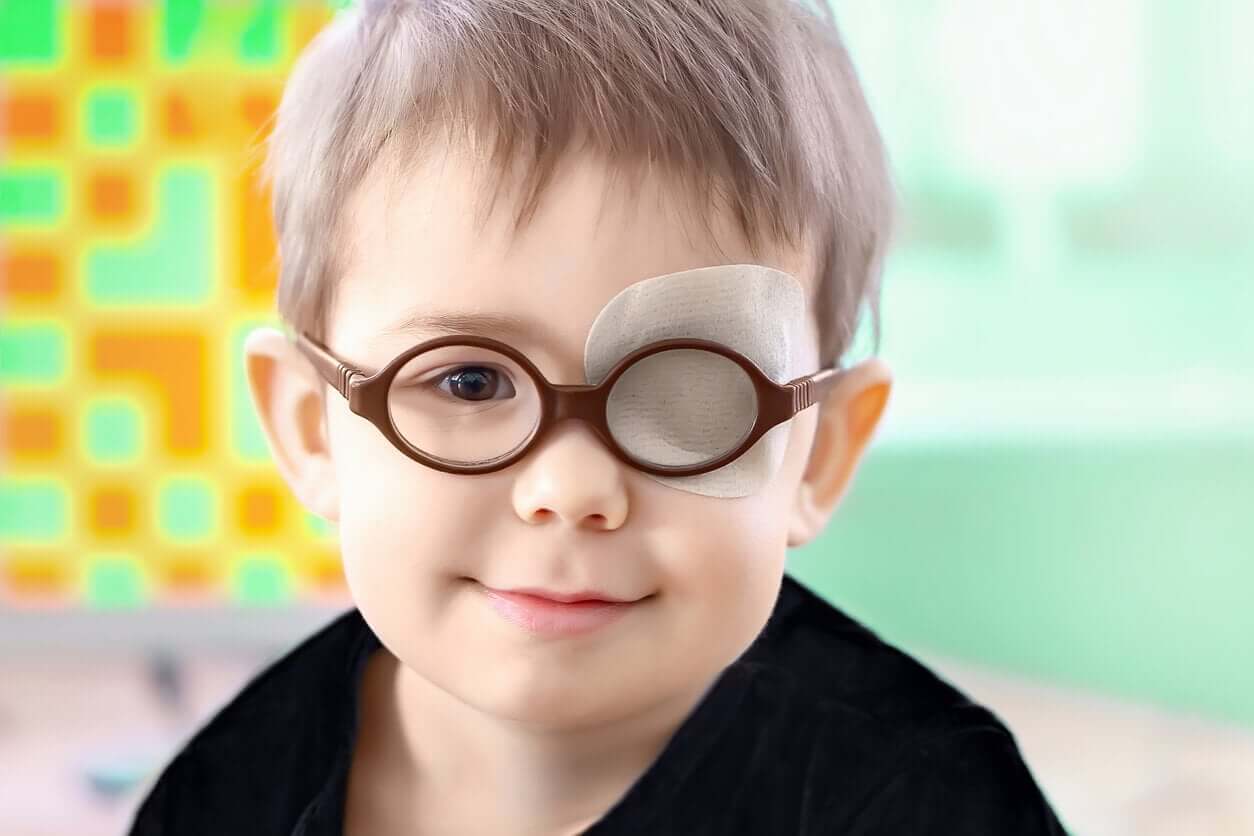Strabismus in Babies: Symptoms, Causes, and Treatment

Strabismus is a disorder in the alignment of the eyes, which hinders the binocular vision (with both eyes) that we’re used to. It can manifest itself from the time babies are very young and it’s important to know about it.
This defect is quite common in childhood and, according to estimates, 4 out of 100 children under 6 years of age suffer from it. However, it must be detected and corrected in time, as one of its consequences is the loss of vision in the affected eye.
Find out more about what this condition involves and how to help your baby.
What is strabismus?
The term strabismus means ‘oblique gaze’ and refers to the deviation from the normal axis of the eye.
Since we’re born with two eyeballs, the alignment of these is essential in order to provide the brain with the appropriate information. The goal is that both eyes complement each other in this task and give you a wider and deeper range of vision.
When one or both eyes are misaligned, the brain receives confusing and often overlapping information. Therefore, one of the strategies to avoid this double stimulus is to cancel the arrival of information from one of them. This phenomenon is known as amblyopia and is the significant (and sometimes irreversible) loss of visual ability.
Unfortunately, between 2 and 5% of children with strabismus suffer this outcome, so detecting and treating this condition early is essential.
Types of strabismus
There are different classes of strabismus and, to define them, there are several classifications. If we take into account the direction of the deviation of the affected eye, we can determine the following types:
- Convergent (or esotropia ): The deviation of the eyeball is inward. That is, it looks towards the nose.
- Divergent (or exotropia ): In this case, the deviation is outward from the face, always horizontally.
- By lateral deviations: This includes hypertropias (looking up), hypotropias (looking down), and dissociated lateral deviation.

Why does strabismus in babies occur?
As in most developmental disorders, the cause is multifactorial. In any case, there’s an important genetic load that determines its appearance. So much so that, when it occurs in a child, almost half of their relatives have a similar antecedent.
Several factors determining the alignment of the eyes. Among them, the configuration of the face, the ability of the eye muscles to position the eye according to the purpose, and the neurological state of the child.
When the baby has a genetic disorder, such as collagen disease or one having to do with the development of the bones, their face may be somewhat more elongated than usual. Therefore, some structures may be further apart from each other. In the case of the eyes, this can cause a false appearance of strabismus, even though the axis of both is adequate. This condition is known as pseudostrabismus.
On the other hand, any disease that involves the eye muscles can lead to strabismus. One of the most common causes is muscular paralysis of some cranial nerves and cerebral palsy.
Finally, any injury to an ocular structure can favor this situation, as it could function as a compensatory mechanism and not as a primary defect. Therefore, strabismus can be the manifestation of a congenital cataract in young babies.
The diagnosis of strabismus in babies?
Ocular deviation is often pronounced and can be seen with the naked eye. This is something common and physiological during the first months of life, due to the immaturity of the eye muscles. However, if it persists after the sixth month, it should put us on alert.
Clinical manifestations
Below are some signs or symptoms that accompany strabismus:
- Double vision or diplopia
- Difficulty fixing your eyes on a stimulus
- Visual fatigue
- Headaches
- Inappropriate neck or back postures (to compensate for the tilt of the eye)
- Muscle contractures
Ophthalmological tests
In the consult with the pediatrician, the professional will carry out certain tests in order to obtain information about the state of health and the development of the organs of vision.
From birth, doctors can perform a direct visual examination of the eye to see defects in the superficial structures. Also, they can perform the Brückner or red reflex and supplement the information with visual evoked potentials.
During this stage, strabismus can be observed intermittently, as part of the ocular maturation process. But if the deviation is constant, parents should consult with a specialist.
After 6 months, the physiological strabismus tends to disappear, and in addition to the red reflex, experts recommend evaluating the child’s ability to fixate on an object. Initially, this can involve a toy or the face of the examiner themself.
From one year on, the child can collaborate to take two more specific tests, such as the Hirschberg test and the Cover Test. In the first, the professional asks the child to stare into the light of the flashlight, located a few centimeters away. If the light falls on the pupil in both eyes, then the alignment is considered correct.
The second test consists of evaluating each eye separately and is reserved for those cases in which the Hirschberg test casts doubt. To do this, the professional must cover one eye at a time and assess the ability of the uncovered eye. In most cases, a children’s ophthalmologist performs this test.
Every time there’s a possible case of strabismus, consulting a specialist is necessary.
Treatment of strabismus in babies

The objective of the treatment of strabismus in babies is to collaborate in order to reestablish the binocular vision of the child and prevent future problems. The brain of children is very permeable to changes, but this advantage doesn’t take long to disappear. Therefore, early diagnosis and treatment should be a priority to avoid amblyopia.
In the first instance, doctors attempt optical correction through the use of patches or glasses that nullify the vision of a single eye. The most common is the use of adhesive patches (which is the most efficient), although the choice depends on the conditions of each child.
The preferential strategy for the use of the patches is total, permanent (all day), and alternating (some days on one side and others on the other side) occlusion. When this treatment takes place before 4 years of age, the prognosis is usually quite good.
In older children or in those who haven’t responded to the instance of occlusion or have more complex illnesses, surgical treatment is usually the best option.
About the importance of regular visits to the children’s ophthalmologist
Our eyes are a perfect window to the world and we must take care of them from day one. For this reason, it’s very important to carry out routine consultations with the pediatrician, as well as the necessary ophthalmological studies of the first year of life.
The early detection of any condition that affects the child’s vision is key to improving their future prognosis. Whenever you have doubts, talk to your doctor and avoid wasting precious time.
Strabismus is a disorder in the alignment of the eyes, which hinders the binocular vision (with both eyes) that we’re used to. It can manifest itself from the time babies are very young and it’s important to know about it.
This defect is quite common in childhood and, according to estimates, 4 out of 100 children under 6 years of age suffer from it. However, it must be detected and corrected in time, as one of its consequences is the loss of vision in the affected eye.
Find out more about what this condition involves and how to help your baby.
What is strabismus?
The term strabismus means ‘oblique gaze’ and refers to the deviation from the normal axis of the eye.
Since we’re born with two eyeballs, the alignment of these is essential in order to provide the brain with the appropriate information. The goal is that both eyes complement each other in this task and give you a wider and deeper range of vision.
When one or both eyes are misaligned, the brain receives confusing and often overlapping information. Therefore, one of the strategies to avoid this double stimulus is to cancel the arrival of information from one of them. This phenomenon is known as amblyopia and is the significant (and sometimes irreversible) loss of visual ability.
Unfortunately, between 2 and 5% of children with strabismus suffer this outcome, so detecting and treating this condition early is essential.
Types of strabismus
There are different classes of strabismus and, to define them, there are several classifications. If we take into account the direction of the deviation of the affected eye, we can determine the following types:
- Convergent (or esotropia ): The deviation of the eyeball is inward. That is, it looks towards the nose.
- Divergent (or exotropia ): In this case, the deviation is outward from the face, always horizontally.
- By lateral deviations: This includes hypertropias (looking up), hypotropias (looking down), and dissociated lateral deviation.

Why does strabismus in babies occur?
As in most developmental disorders, the cause is multifactorial. In any case, there’s an important genetic load that determines its appearance. So much so that, when it occurs in a child, almost half of their relatives have a similar antecedent.
Several factors determining the alignment of the eyes. Among them, the configuration of the face, the ability of the eye muscles to position the eye according to the purpose, and the neurological state of the child.
When the baby has a genetic disorder, such as collagen disease or one having to do with the development of the bones, their face may be somewhat more elongated than usual. Therefore, some structures may be further apart from each other. In the case of the eyes, this can cause a false appearance of strabismus, even though the axis of both is adequate. This condition is known as pseudostrabismus.
On the other hand, any disease that involves the eye muscles can lead to strabismus. One of the most common causes is muscular paralysis of some cranial nerves and cerebral palsy.
Finally, any injury to an ocular structure can favor this situation, as it could function as a compensatory mechanism and not as a primary defect. Therefore, strabismus can be the manifestation of a congenital cataract in young babies.
The diagnosis of strabismus in babies?
Ocular deviation is often pronounced and can be seen with the naked eye. This is something common and physiological during the first months of life, due to the immaturity of the eye muscles. However, if it persists after the sixth month, it should put us on alert.
Clinical manifestations
Below are some signs or symptoms that accompany strabismus:
- Double vision or diplopia
- Difficulty fixing your eyes on a stimulus
- Visual fatigue
- Headaches
- Inappropriate neck or back postures (to compensate for the tilt of the eye)
- Muscle contractures
Ophthalmological tests
In the consult with the pediatrician, the professional will carry out certain tests in order to obtain information about the state of health and the development of the organs of vision.
From birth, doctors can perform a direct visual examination of the eye to see defects in the superficial structures. Also, they can perform the Brückner or red reflex and supplement the information with visual evoked potentials.
During this stage, strabismus can be observed intermittently, as part of the ocular maturation process. But if the deviation is constant, parents should consult with a specialist.
After 6 months, the physiological strabismus tends to disappear, and in addition to the red reflex, experts recommend evaluating the child’s ability to fixate on an object. Initially, this can involve a toy or the face of the examiner themself.
From one year on, the child can collaborate to take two more specific tests, such as the Hirschberg test and the Cover Test. In the first, the professional asks the child to stare into the light of the flashlight, located a few centimeters away. If the light falls on the pupil in both eyes, then the alignment is considered correct.
The second test consists of evaluating each eye separately and is reserved for those cases in which the Hirschberg test casts doubt. To do this, the professional must cover one eye at a time and assess the ability of the uncovered eye. In most cases, a children’s ophthalmologist performs this test.
Every time there’s a possible case of strabismus, consulting a specialist is necessary.
Treatment of strabismus in babies

The objective of the treatment of strabismus in babies is to collaborate in order to reestablish the binocular vision of the child and prevent future problems. The brain of children is very permeable to changes, but this advantage doesn’t take long to disappear. Therefore, early diagnosis and treatment should be a priority to avoid amblyopia.
In the first instance, doctors attempt optical correction through the use of patches or glasses that nullify the vision of a single eye. The most common is the use of adhesive patches (which is the most efficient), although the choice depends on the conditions of each child.
The preferential strategy for the use of the patches is total, permanent (all day), and alternating (some days on one side and others on the other side) occlusion. When this treatment takes place before 4 years of age, the prognosis is usually quite good.
In older children or in those who haven’t responded to the instance of occlusion or have more complex illnesses, surgical treatment is usually the best option.
About the importance of regular visits to the children’s ophthalmologist
Our eyes are a perfect window to the world and we must take care of them from day one. For this reason, it’s very important to carry out routine consultations with the pediatrician, as well as the necessary ophthalmological studies of the first year of life.
The early detection of any condition that affects the child’s vision is key to improving their future prognosis. Whenever you have doubts, talk to your doctor and avoid wasting precious time.
All cited sources were thoroughly reviewed by our team to ensure their quality, reliability, currency, and validity. The bibliography of this article was considered reliable and of academic or scientific accuracy.
- Puertas, D (2003). Estrabismo. España. Anales de Pediatra Continuas 2003;1(2):105-8. Recuperado de: https://www.elsevier.es › pRevista=pdf-simple
- Merchante Alcántara. Estrabismo y ambliopía. Pediatr Integral 2013; XVII(7): 489-506. Disponible en: https://www.pediatriaintegral.es/wp-content/uploads/2013/xvii07/04/489-506%20Estrabismo.pdf
- Diez del Corral Belda JM et al. Oftalmología para el pediatra de atención primaria. Form Act Pediatr Aten Prim 2013;6(3) 175-83. Disponible en: https://fapap.es/articulo/255/oftalmologia-para-el-pediatra-de-atencion-primaria
- Rogers GL, Olson Jordan C. Pediatric Vision Screening. Pediatrics in Review 2013;34;126. DOI: 10.1542/pir.34-3-126. Disponible en: https://pedsinreview.aappublications.org/content/34/3/126
- Olitsky SE, et al. Disorders of the eye movement and alignment. Chapter 623. En: Kliegman R, Stanton B, St Geme J et al. Nelson Textbook of Pediatrics. 20th Edition. Elsevier. Philadelphia. 2016. p 3026-3033.
- Pérez Cambrodí R, Díaz A, Carreres M. Desviación Vertical Disociada. Caso clínico. Congreso Internacional de Optometría, Contactología y Óptica Oftálmica. Madrid, 2004. Disponible en: https://www.researchgate.net/publication/265013134_Desviacion_Vertical_Disociada_Caso_clinico
- Merino P., Gómez-de-Liaño P., Gil M.R., Fernández A.I., Yáñez J., Cortés C.. Estrabismo y cataratas congénitas. Arch Soc Esp Oftalmol [Internet]. 2007 Oct [citado 2021 Sep 22] ; 82( 10 ): 623-628. Disponible en: http://scielo.isciii.es/scielo.php?script=sci_arttext&pid=S0365-66912007001000006&lng=es.
This text is provided for informational purposes only and does not replace consultation with a professional. If in doubt, consult your specialist.








